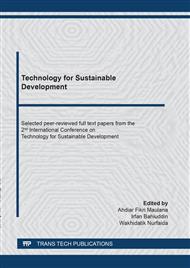[1]
I. Masser, All Shapes and Sizes: The First Generation of National Spatial Data Infrastructure. Paper presented at the Selected Conference Papers of the Third Global Spatial Data Infrastructure Conference, Canberra, (1998).
DOI: 10.1201/9780429505904-11
Google Scholar
[2]
R.W. Matindas, Puntodewo, & B. Purnawan, Development of National Spatial Data Infrastructure in Indonesia. FIG Working Week, Athens, Greece, (2004).
Google Scholar
[3]
J. Ogunbiyi, Reviewing the status of National Spatial Data Infrastructure: A case study in Southern African Countries [Diploma Thesis, Technische Universität Wien], 2021, https://doi.org/10.34726/hss.2021.89045.
Google Scholar
[4]
Y. Guigoz, G. Giuliani, A. Nonguierma, A. Lehmann, A. Mlisa, N. Ray, Spatial Data Infrastructures in Africa: A Gap Analysis. Journal of Environmental Informatics, September 2017, Vol. 30 Issue 1, pp.53-62. 10p.
Google Scholar
[5]
A. Farida, Evaluasi Kesiapan Infrastruktur Data Spasial Di Pemerintah Kabupaten/Kota Menggunakan Kuesioner Evaluasi Diri Dan Technology Acceptance Model, Thesis of Master Program, Geomatics Engineering Master Study Program, Universitas Gadjah Mada Yogyakarta, (2014).
DOI: 10.29408/geodika.v6i1.4480
Google Scholar
[6]
M.R. Gamez, A.V. Perez, V.A.M. Falcones, J.J.B Bazurto, The Geoportal as Strategy for Sustainable Development International Journal of Physical Sciences and Engineering. Vol. 3 No. 1, April 2019, pages: 10~21 e-ISSN : 2550-6943, p-ISSN : 2550-6951.
DOI: 10.29332/ijpse.v3n1.239
Google Scholar
[7]
Geospatial Information Agency of the Republic of Indonesia, Kinerja Simpul Jaringan Indonesia 2018, Bogor, Indonesia, 1st print – October (2019).
Google Scholar
[8]
Information on https://jdih.big.go.id/media/resources/law/keputusan-deputi-bidang-infrastruktur-informasi-geospasial-badan-informasi-geospasial-nomor-11-tahun-2019-tentang-rencana-strategis-deputi-bidang-infrastruktur-informasi-geospasial-badan-informasi-geospasial-tahun-2016-2019/.
DOI: 10.21063/spi3.1017.228-242
Google Scholar
[9]
J. Smith, L. Ting, & I. Williamson, Developing a common spatial data infrastructure between state and local government: An Australian case study. International Journal of Geographical Information Science, 16(4), 305-322, (2002).
DOI: 10.1080/13658810110096001
Google Scholar
[10]
M. Barbero, et. al., The Role of Spatial Data Infrastructures in the Digital Government Transformation of Public Administration, Luxembourg: Publications Office of the European Union, 2019, ISBN 978-92-76-09679-5.
Google Scholar
[11]
TYD. Putra, Y. Sekimoto, R. Shibasaki, Toward the Evolution of National Spatial Data Infrastructure Development in Indonesia, ISPRS International Journal of Geo-Information, 2019 ( 8, 263),.
DOI: 10.3390/ijgi8060263
Google Scholar
[12]
G.S. Hubona & P.H. Cheney, System effectiveness of knowledge-based technology: the relationship of user performance and attitudinal measures. Paper presented at the Twenty-Seventh Hawaii International Conference, Wailea, HI, USA, (1994).
DOI: 10.1109/hicss.1994.323465
Google Scholar
[13]
I. Yuadi, Analisis Technology Acceptance Model terhadap Perpustakaan Digital dengan Structural Equation Modeling. Departemen Ilmu Informasi dan Perpustakaan, (2009).
DOI: 10.29240/tik.v6i2.4438
Google Scholar
[14]
P. A. M. W. Wida, et. al., Aplikasi Model TAM (Technology Acceptance Model) pada Perilaku Pengguna Instagram." Jurnal Ilmu Manajemen Mahasaraswati, 2016, vol. 6, no. 2.
Google Scholar
[15]
S. Naspetti, S. Mandolesi, J. Buysse, T. Latvala, P. Nicholas, S. Padel, E.J. Van Loo, R. Zanoli, Determinants of the Acceptance of Sustainable Production Strategies among Dairy Farmers: Development and Testing of a Modified Technology Acceptance Model. Sustainability 2017, 9, 1805. https://doi.org/10.3390/su9101805.
DOI: 10.3390/su9101805
Google Scholar
[16]
A. Granić, N. Maragunić, Technology acceptance model in educational context: A systematic literature review, British Journal of Education Technology, 2019, https://doi.org/10.1111/ bjet.12864.
Google Scholar
[17]
F.D. Davis, Perceived usefulness, perceived ease of use, and user acceptance of information technology, MIS Quarterly, 1993, Vol.13, No.3, pp.319-340.
DOI: 10.2307/249008
Google Scholar
[18]
S. Y. Wang, Y.M. Wang., H. Lin., dan T.I. Tang. Determinants of User Acceptance of Internet Banking: An Empirical Study, International Journal of Service Industry Management, Vol. 14, No. 5, pp.501-519, (2003).
DOI: 10.1108/09564230310500192
Google Scholar
[19]
A. Wibowo, Kajian Tentang Perilaku Pengguna Sistem Informasi Dengan Pendekatan Technology Acceptance Model (TAM). Jakarta Selatan : Program Studi Sistem Informasi, Fakultas Teknologi Informasi Universitas Budi Luhur, (2006).
DOI: 10.29408/edumatic.v4i1.2130
Google Scholar


